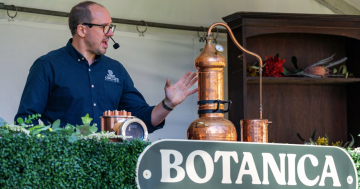
Underground Spirits CEO Claudia Roughly. Photo: Michelle Kroll.
Canberra’s well-known appreciation of craft spirits follows the global trend that has produced a variety of new approaches to making a good drink.
Despite the popularity, many don’t understand how to make a nice gin. It can vary in quality as much as any joke shared on a night out.
In the eyes of Underground Spirits CEO Claudia Roughley, it “has got to tell a story”.
At the Underground craft distillery, Claudia leads a team dedicated to “showing off the history around us by putting the best of Canberra into every bottle”, inspired by the global popularity of artisans who want to make drinks celebrating their regions, instead of big brand, mass-producing companies who ignore it.
Claudia says larger competitors “keep doing the same thing, there’s no real craft, science, or refinement being applied after the mass-scale distilling process”.
She says the Underground Spirits artisan gin-making process excels where the big brands do not – taking care to refine the spirits “and take out all the nasties”.
“We’re really blessed in Australia because we have lots of wonderful ingredients.”
Making gin is a three-step process involving maceration, vapour infusion and tinctures.
For Underground Spirits, maceration begins with high-quality NSW wheat made into a base alcoholic spirit, which is then distilled with beautiful Snowy Mountains spring water.
Claudia says the base spirit, ethanol, is “very harsh and horrible to drink”. It’s here where Underground goes the extra mile.
First suspending the impurities in the liquid by cooling it to sub-zero temperatures, it’s then pushed through a micron-sized filter “to make sure the gin is smooth, easy to drink, and has a perfect finish”.
This allows the team to add the unique flavours native to Canberra without any interference in taste. Claudia says it means the public enjoys an “amazing array of beautiful botanicals”.
To help introduce the diverse flavours grown in the region, Underground Spirits began working with the Australian National Botanic Gardens during the site’s 50th anniversary in 2020. Although the three most common botanicals used are juniper, coriander and angelica root, this year’s gin used the gardens’ Banksia plants.

Underground Spirits staff collect the alcoholic vapours from the still in a small beaker. Photo: Michelle Kroll.
In the past, the team has extracted and used the seed pods of the Kurrajong. Claudia says the team pulls out the thorns before roasting the pods to infuse a popcorn flavour within the gin.
The liquid and botanicals then sit overnight in two stills. “Kind of like a giant tea bag that draws out into the alcohol and flavours from all those chosen botanicals,” she says.
“In the morning we come in and turn on the still, heating it up until the vapours rise from the boiling liquid to pass through copper coils and a basket at the top.”
The age-old use of copper, as perfected by the Christian monks, helps to remove impurities.
Dry botanicals sit in the basket, a method commonly known to produce London Dry Gin. Claudia says there are “no rules on what you can put in the basket… some put whole fruits in”.

Tinctures are measured from drop bottle to beaker by Underground Spirits staff. Photo: Michelle Kroll.
The end liquid product is condensed and left in a vat to sit before the final step of, drop by drop, infusing the botanicals in the gin, which in this process are called tinctures. Tasmanian Pepper Berries are one example of a botanical, which in Claudia’s opinion produce a “lovely spiciness to really complement and fulfill the flavours” of the gin.
The end liquid product is condensed and left in a vat to sit before the final step – infusing the botanicals, known as tinctures during the process, into the gin drop by drop. Claudia says botanicals such as Tasmanian pepper berries produce a lovely spiciness to complement and fulfill the gin’s flavours.
In an age when we’re more concerned about what we’re eating and how it’s produced, Underground Spirits wants to help share and celebrate the story of Canberra as a gin makers’ paradise.
For further information, visit Underground Spirits.





















